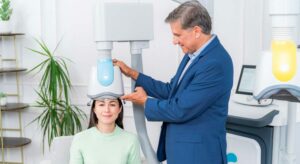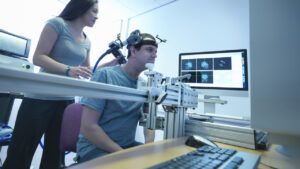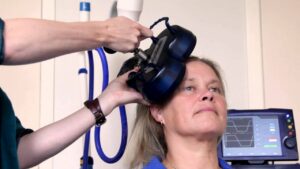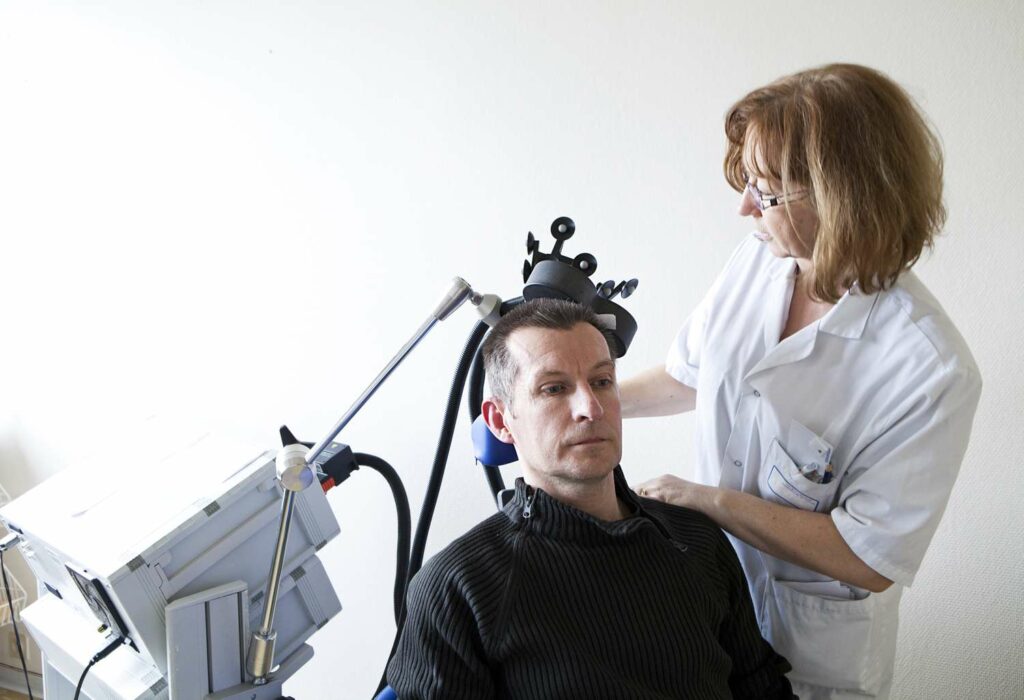RTMS stands for Repetitive transcranial magnetic stimulation, which is a form of therapy that can help people with OCD. There are a few types of RTMS therapy, and each has its benefits and drawbacks. This article will cover the most common type of RTMS therapy, repetitive transcranial magnetic stimulation over the left prefrontal cortex (rTMS-LFP). In this blog learn what RTMS for OCD is, how it works, and what the benefits and limitations are.
Contents
What is RTMS for OCD?

There is a lot of misinformation out there about Repetitive Transcranial Magnetic Stimulation (rTMS). In this blog post, we will clear up some of the myths and give you the facts about this cutting-edge treatment for OCD.
RTMS is a non-invasive brain stimulation technique that uses magnetic fields to stimulate nerve cells in the brain. This treatment is FDA approved for the treatment of major depression. However, research has shown that RTMS can also be effective in treating other mental health conditions, such as OCD.
- One common misconception about RTMS is that it is painful. This is not true! The treatment itself is very well tolerated by most people. Some patients may experience a mild tingling sensation during the procedure, but this typically goes away quickly.
- Another myth about RTMS is that it takes a long time to see results. However, this is not the case! Many patients see significant improvements after just a few sessions of treatment.
If you or someone you know is struggling with OCD, please don’t hesitate to reach out to us for more information about RTMS and how it could help!
The Different Types of RTMS for OCD
There are two different types of rTMS for OCD: high-frequency and low-frequency.
- High-frequency rTMS is the most commonly used type of rTMS for OCD. It involves delivering rapid pulses of magnetic energy to the brain. This type of rTMS is thought to work by disrupting the communication between the areas of the brain that are involved in OCD.
- Low-frequency rTMS is a newer type of rTMS that is being studied for its potential use in treating OCD. Low-frequency rTMS involves delivering pulses of magnetic energy at a lower rate than high-frequency rTMS. This type of rTMS is thought to work by stimulating the part of the brain that is involved in OCD.
Both types of rTMS are effective in reducing symptoms of OCD, although high-frequency rTMS is more effective than low-frequency rTMS.
There are three different types of RTMS for OCD:
- Inclusive RTMS: This type of RTMS includes all aspects of OCD, from obsessions to compulsions. It is the most comprehensive type of RTMS and usually takes longer to complete than the other two types.
- FocusedRTMS: This type of RTMS focuses on one specific aspect of OCD, either the obsessions or the compulsions. It is less comprehensive than InclusiveRTMS but can be completed in a shorter time frame.
- CombinedRTMS: This type of RTMS combines both InclusiveRTMS and FocusedRTMS into one treatment plan. It is the most effective type of RTMS for OCD but also the longest and most expensive.
What to Expect During an RTMS Session for OCD?

There is no one-size-fits-all approach to treating OCD, as the treatment plan will vary depending on the individual’s symptoms and history. However, some general steps that are often taken during an RTMS session for OCD include:
Discussion of Your Goals
One of the main common goals of RTMS for OCD is to help individuals learn how to manage their symptoms more effectively. During the session, you and the patient will discuss specific goals that the individual wants to achieve, such as reducing anxiety levels, managing intrusive thoughts more effectively, or avoiding compulsive behaviors.
Assessment
During an RTMS session for OCD, your therapist will use a variety of assessment tools to determine the severity of the individual’s symptoms and help develop a treatment plan accordingly. This may include questioning the individual about their anxiety levels, intrusive thoughts, and compulsions; conducting a mental health history; and reviewing medical records.
Teaching coping skills
One of the main goals of RTMS for OCD is to teach individuals effective ways to manage their anxiety and intrusive thoughts. During sessions, your therapist may teach specific stress-relieving techniques such as deep breathing or mindfulness meditation, or guide how to deal with intrusive thoughts in a healthy manner. Some of the most common coping skills that are taught during RTMS for OCD include problem-solving, Cognitive Behavioral Therapy (CBT), and relaxation techniques.
Treatment plan
After assessing the individual’s symptoms and goals, your therapist will develop a specific treatment plan that focuses on helping the individual manage their anxiety and intrusive thoughts more effectively. This may include teaching stress-relieving techniques, providing support to avoid compulsive behaviors, and helping the individual develop healthy coping skills.
Working on RTMS For OCD
RTMS or repetitive transcranial magnetic stimulation is a treatment that is effective in treating obsessive-compulsive disorder (OCD). This type of therapy uses a magnetic field to help change the way the brain processes thoughts and memories.
There are two main types of RTMS for OCD: closed-loop RTMS and open-loop RTMS. Closed-loop RTMS uses a magnet to only stimulate specific parts of the brain, while open-loop RTMS allows for more general stimulation.
- The working of RTMS is classified in two ways: top-down and bottom-up. Top-down RTMS works by inhibiting a certain part of the brain, while bottom-up RTMS works by stimulating a certain part of the brain.
- In the working phase of RTMS, a patient is first placed in an MRI machine. This will help to create a map of the patient’s brain. The MRI machine will also be used to help position the magnet in the desired location.
- Once the magnet is in place, the RTMS therapy begins. The therapy is conducted daily for around 20 minutes. During this time, the patient is asked to repeat certain phrases or thoughts over and over again.
- The goal of RTMS for OCD is to change the way the brain processes thoughts and memories. By using magnetic stimulation to inhibit certain parts of the brain, patients may be able to reduce their symptoms.
How Often Should an RTMS Session be Conducted?

The duration of an RTMS session should depend on the type of information that is being collected and the complexity of the data analysis. For example, an RTMS session that collects demographic data may only require a single session while an RTMS session that collects medical data may require multiple sessions over time to achieve optimal results.
For about half of the patients in a study, repeated measurements over time would result in more precise estimates of the average heart rate.
Generally, an RTMS session should be conducted every two to four weeks. These sessions can be used to collect new data or to update data that has been collected previously.
Benefits of RTMS For OCD
There are many benefits to using RTMS for OCD. Some of these are:
Helps To Know Your Intrusive Thoughts
One of the most common benefits of using RTMS is that it helps to track the thoughts that are intrusive and cause anxiety. This can be very helpful in learning how to manage these thoughts and minimize their impact.
Helps To Manage Anxiety And Stress
Another common benefit of using RTMS is that it can help to manage anxiety and stress. When you know what intrusive thoughts are causing your anxiety, you can start to learn how to respond differently to minimize the impact of those thoughts. This can lead to a reduced level of anxiety and better overall mental health.
Helps To Identify The Root Cause Of OCD Symptoms
Using RTMS can also help identify the root cause of OCD symptoms. By understanding the thought patterns that are causing your symptoms, you can start to make changes that will lead to a more permanent solution. These also may include changes to your lifestyle or medication.
Encourages A Change In Perspective
One of the most important benefits of using RTMS is that it can help you change your perspective on OCD. When you understand the thought patterns that are driving your OCD, you can start to see them in a different light. This can help you to start to accept and cope with them rather than fight against them.
Limitations of RTMS For OCD

With RTMS, there are some limitations to consider. Some of the limitations can be:
Headaches
Sometimes people experience headaches with RTMS treatment. This can be a result of the stress that the treatment can cause. Some people find that taking medication to relieve their headaches helps. When headaches occur, it is important to talk to a doctor about the treatment and possible ways to manage them.
Sensitivity to light
Some people experience sensitivity to light during RTMS treatment. This can be a result of the bright lights that are used during the treatment. Some people find that wearing sunglasses or avoiding bright lights helps. When sensitivity to light occurs, it is important to talk to a doctor about the treatment and possible ways to manage it.
Stress
RTMS can be a very stressful treatment. It is important for people who are considering RTMS treatment to understand the risks and benefits of the treatment before starting it. People should also be aware of any potential stressors in their lives that could increase their risk of developing OCD. If it is difficult for someone to manage their stress, they may want to consider other treatment options before beginning RTMS.
Nausea
Anxiety can cause people to experience nausea. This can be a problem during the initial weeks of RTMS treatment, but it usually goes away over time. If nausea is a problem, people may find that taking medication to relieve their nausea helps. When nausea occurs, it is important to talk to a doctor about the treatment and possible ways to manage it.
Conclusion
RTMS is a treatment that uses magnets to help change the way the brain processes thoughts and memories. It is a common treatment for OCD, and there are many benefits to using it. Generally, an RTMS session should be conducted every two to four weeks. There are some limitations to consider when using RTMS, such as headaches and sensitivity to light.
For more information and guidance, please contact OCDMantra. OCD is a mental health disorder characterized by obsessions and compulsions. If you have any queries regarding OCD treatment, ERP therapy experienced therapists at OCDMantra can help: Book a trial OD therapy session.


